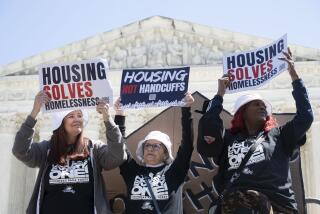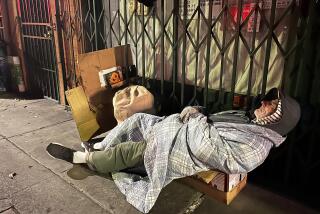Opinion: How can L.A. build dense new housing without displacing working families? With a ‘Right to Remain’
Los Angeles is in the grip of a housing crisis. Rents have been skyrocketing for years, and the diversity and vibrancy that make our city great are in danger of being snuffed out as low-income Angelenos are displaced and evicted. The growing consensus is that we need to build far more housing to stop the crisis. Most new housing developments don’t replace existing multifamily buildings. But when they do, the families who live in those buildings have their lives turned upside down.
Under current law, when a rent-stabilized building is torn down to make way for new development, evicted residents receive relocation payments ranging from $7,000 to $20,000 — depending on their age, income and length of residency. But with L.A.’s recent rapid rent increases, these payouts often aren’t enough to afford new housing in the same neighborhood. Instead, residents are displaced from their community.
Dense new development can provide homes for 80 where there used to be homes for eight, but that’s no consolation for the eight families who lose their home.
It doesn’t have to be this way. We can, and should, establish a “Right to Remain” for tenants who are displaced by new housing construction.
At a high level, Right to Remain works like this: Families who live in buildings slated for redevelopment could, in lieu of their traditional relocation checks, choose instead to move back into their redeveloped building at the same stabilized rent as before. During construction, developers would be required to find displaced tenants a nearby apartment and pay for all moving costs.
Right to Remain expands and improves on a policy that has been tried in Chicago and Washington, D.C., called “Right to Return.” These programs were created during the redevelopment of government-owned public housing to give existing residents the right to return once replacement housing had been constructed.
Despite its good intentions, Right to Return has some noticeable shortcomings. Thus far, programs have failed to create as much replacement housing as they have demolished; agencies tore down homes without sufficient money on hand to pay for redevelopment. In Chicago, Right to Return also failed to keep families in their local community during the construction process. At the LeClaire Courts project, for instance, 600 families are still scattered across the city nine years after they were evicted. Construction of a replacement building has not even started. Long moves like this force people to find new jobs and build lives elsewhere, making it harder to return, even after projects are finished.
Right to Remain would apply to rent-stabilized housing rather than public housing — and would address Right to Return’s shortcomings in three ways. First, demolition permits wouldn’t be issued until the building permits to replace the lost units were approved. L.A. also can ensure that financial incentives are aligned so that projects do not go uncompleted. Developers who fail to complete a project and rehouse displaced residents within a reasonable period of time (say, five years) could see the city seize their property. Finally, families can be kept in their communities by requiring that developers find residents interim apartments in the neighborhood during the construction process.
Right to Remain could fit into state or local law in a number of ways — but it would be most effective to pair it with upzoning (zone changes that allow for denser housing to be built). Rent is rising in Los Angeles because we build far too little housing to accommodate our children and the job-seekers who move here. That resulting housing shortage gives landlords all the negotiating power. Upzoning allows more housing to be built, giving renters more options — and therefore more leverage with landlords. In combination with the Right to Remain, upzoning can provide enough housing to bring rents down while making sure that no one is displaced along the way.
SB 827, a California law being proposed by state Sen. Scott Wiener (D-San Francisco), could be just the right fit. The bill would rezone all areas within 1/4 mile of major transit corridors to allow four- to eight-story residential buildings to be built by right. That is exactly the kind of transformative thinking we need to address the housing crisis, stop gridlock and reduce greenhouse gas emissions. However, the bill as currently proposed relies on local jurisdictions to protect tenants, and the senator is actively looking for amendments to fill that gap.
Amending the bill to include the Right to Remain would allow for the development of much-needed housing along transit corridors, without fear of displacement or eviction. Existing residents could feel more secure knowing that they would benefit from growth in their neighborhood because their rent-stabilized unit no longer would be under threat from redevelopment.
L.A. needs rapid transit-oriented growth if we want to stop the rent increases, maintain our diversity, reduce congestion and smog and increase economic mobility. A Right to Remain can help us achieve those goals while ensuring that our city’s prosperity equitably benefits all Angelenos.
Brent Gaisford is the director of Abundant Housing LA, an all-volunteer housing advocacy organization with 1,500 members across Los Angeles County. He also is the co-founder and COO of Treehouse Co-Living, a builder and manager of community-focused apartment buildings.
Follow the Opinion section on Twitter @latimesopinion or Facebook
More to Read
A cure for the common opinion
Get thought-provoking perspectives with our weekly newsletter.
You may occasionally receive promotional content from the Los Angeles Times.










